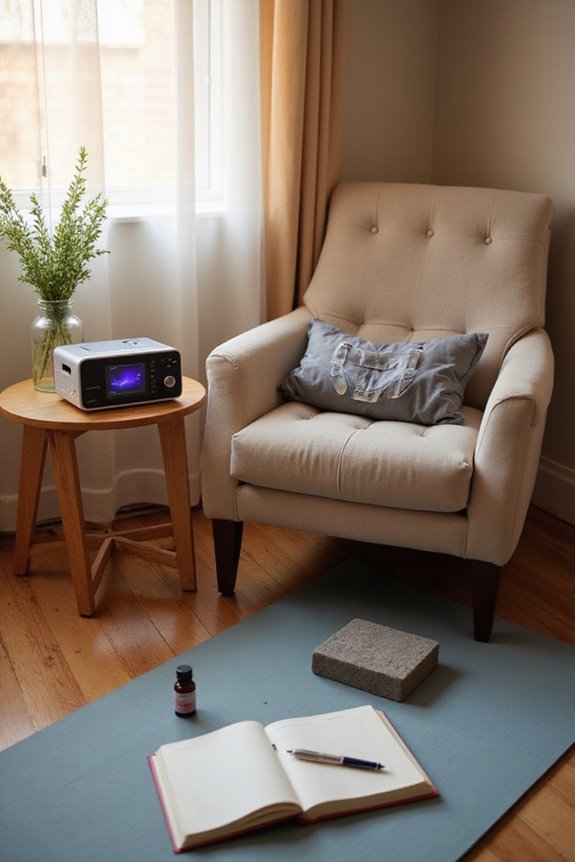Preventing pain during aging involves an extensive strategy that addresses multiple factors. Key approaches include:
- Engaging in regular physical activity to enhance mobility and reduce pain intensity.
- Utilizing cognitive behavioral therapy to alter pain perception and improve function.
- Implementing mindfulness techniques to foster pain acceptance.
- Strengthening social connections to enhance emotional well-being.
- Participating in community-based pain management programs for holistic support.
Effective pain management strategies can considerably improve quality of life for older adults, leading to better health outcomes. More insights await.
Key Takeaways
- Engage in regular physical activity to reduce pain intensity and enhance mobility throughout the aging process.
- Incorporate mindfulness techniques like meditation to alleviate pain perception and promote relaxation.
- Utilize cognitive behavioral therapy to challenge negative thoughts and improve pain management strategies.
- Foster social connections and participate in community activities to enhance emotional well-being and decrease feelings of isolation.
- Consider multidisciplinary rehabilitation programs that integrate psychological support with physical therapies for comprehensive pain management.
Understanding Age-Related Changes in Pain Processing
As individuals age, significant physiological transformations occur within their nervous systems, which can profoundly affect their experience of pain.
Key changes include:
- Neuroplasticity Changes: Aging leads to alterations in synaptic plasticity, impacting pain processing.
- Sensory Processing: Enhanced central modulation results in increased pain sensitivity despite higher pain thresholds for certain stimuli.
- Neuroinflammation Effects: Chronic neuroinflammation can exacerbate pain states, affecting pain perception.
- Transmitter Loss: Diminished serotonergic and noradrenergic neurons in the spinal cord heightens pain signaling.
- Spinal Cord Changes: Degenerative alterations in spinal dorsal horn neurons impair pain signal transmission.
Understanding these factors is essential for addressing age-related pain, highlighting the need for targeted interventions to manage discomfort effectively in older populations.
The Role of Non-Pharmacological Approaches

Non-pharmacological approaches play a noteworthy role in managing pain among older adults, especially in light of the age-related changes previously outlined. These interventions, including exercise and mindfulness techniques, provide effective alternatives to medication.
Key non-pharmacological interventions include:
- Physical Activity: Regular exercise, such as aerobic activities, strength training, tai chi, and yoga, can reduce pain intensity and improve mobility.
- Mindfulness and Relaxation: Techniques like mindfulness-based stress reduction and progressive relaxation alleviate pain perception and muscle tension.
- Manual Therapies: Massage and chiropractic care enhance musculoskeletal health, while heat and cold therapies provide targeted relief. Incorporating back massagers can further aid in muscle relaxation and pain management.
- Multidisciplinary Rehabilitation: Extensive programs address various pain dimensions, integrating psychological support with physical therapies.
These alternative therapies can greatly enhance quality of life for older adults managing chronic pain.
Cognitive Behavioral Therapy for Pain Management

How can Cognitive Behavioral Therapy (CBT) effectively manage pain in older adults? CBT addresses pain perception by modifying maladaptive thoughts and behaviors.
- Cognitive Restructuring: This technique helps individuals identify and challenge negative pain-related thoughts, reducing emotional distress.
- Behavioral Activation: By engaging in activity pacing and goal setting, older adults can improve physical function without worsening their pain.
Research indicates that CBT has small to medium effects on pain intensity and mood in chronic conditions, such as arthritis. Additionally, it reduces pain-related interference in daily activities, enhancing overall quality of life. Sustained benefits are often observed three months post-treatment, emphasizing the importance of addressing psychological distress alongside physical pain for ideal management outcomes.
Benefits of Mindfulness and Relaxation Techniques

What are the benefits of mindfulness and relaxation techniques in managing pain, particularly for older adults? Mindfulness benefits include significant reductions in pain intensity and unpleasantness ratings, as evidenced by numerous studies. Key findings include:
- Mindfulness meditation activates higher-order brain regions, altering pain perception.
- Techniques like body scan meditation and breath-focused practices effectively reduce stress and pain.
- Long-term practitioners show diminished pain appraisal, enhancing emotional regulation and coping mechanisms.
- A 2017 meta-analysis indicated improved quality of life and reduced reliance on medications among chronic pain patients.
- Mindfulness fosters acceptance of pain, decreasing associated suffering.
Incorporating relaxation techniques into pain management can provide accessible, low-cost options for older adults, enhancing overall well-being without side effects.
Engaging in Regular Physical Activity

Engaging in regular physical activity is essential for older adults, as it plays a crucial role in preventing and managing pain associated with aging.
Exercise Benefits
- Consistent activity reduces the risk of chronic pain development.
- Moderate-intensity aerobic exercise considerably lowers musculoskeletal pain.
- Active older adults report improved pain management and functionality.
- Additionally, incorporating back massagers into a regular routine can enhance muscle relaxation and further alleviate discomfort.
Activity Recommendations
- Authorities recommend moderate to vigorous physical activity tailored to individual capacity.
- Incorporating both aerobic and resistance training supports musculoskeletal health.
- Regular exercise enhances overall quality of life and reduces the risk of chronic diseases.
Implementing Falls Prevention Strategies
Implementing effective falls prevention strategies is essential for older adults to maintain independence and safety.
Home Modifications
- Removing fall hazards can reduce falls by 38%.
- Key modifications include:
- Installing grab bars in bathrooms and handrails on stairs.
- Ensuring adequate lighting in hallways and staircases.
- Using non-slip mats in kitchens and bathrooms.
Medication Management
- Regular medication reviews can identify drugs contributing to dizziness or balance issues.
- Minimizing sedatives and multiple medications lowers fall risk.
- Educating older adults about side effects related to balance enhances safety.
Community-Based Pain Management Programs
Community-based pain management programs play an essential role in addressing the needs of older adults suffering from chronic pain. These programs enhance program accessibility through community engagement, ensuring that underserved populations receive necessary support.
Key components include:
- Psychosocial Interventions: Outperform traditional pharmacological treatments, particularly in underserved areas.
- Shared Medical Appointments: Combine evaluations, counseling, and support to improve outcomes and reduce costs.
- Physical Activity Programs: Promote moderate-intensity exercise to mitigate musculoskeletal pain and reduce fall risks.
- Chronic Disease Self-Management Education (CDSME): Empowers older adults through training, improving self-efficacy and quality of life. Additionally, incorporating heating pads can provide effective relief for various pain types, enhancing the comfort of participants.
Collaboration among local organizations and healthcare providers strengthens these initiatives, ensuring a sustainable approach to effective pain management for the aging population.
The Importance of Psychological Support
Psychological support plays a critical role in improving the quality of life for older adults experiencing chronic pain. Approximately 31% of adults aged 65 and older endure chronic pain, often leading to psychological distress, including anxiety and depression. This distress can exacerbate pain, complicating management strategies.
Key benefits of psychological support include:
- Enhancing psychological resilience and emotional coping, enabling better management of pain.
- Reducing mental health burdens through self-management programs and understanding of pain.
- Increasing the effectiveness of psychosocial interventions, often surpassing pharmacologic treatments.
Older adults with supportive environments report lower perceptions of pain severity. Consequently, integrating psychological support into pain management strategies is essential for enhancing the overall well-being of the aging population facing chronic pain.
Enhancing Social Connections and Support Networks
Social connections greatly influence the well-being of older adults, particularly as they face the challenges of aging. Enhanced social ties can reduce cognitive decline and dementia risk by up to 70%. Engaging in social activities fosters peer engagement, which is essential for emotional and mental health.
Key benefits include:
- Lowered risks of depression and anxiety through meaningful interactions.
- Improved physical health, including better eating and sleeping habits.
- Faster recovery from injuries due to robust support networks.
Programs in senior living communities should prioritize in-person interactions, promoting diverse social activities to enrich connections. By reducing social isolation, older adults can experience enhanced cognitive abilities, overall health, and a greater sense of purpose.
Frequently Asked Questions
How Can Diet Affect Pain Levels in Older Adults?
Diet symbolizes the foundation of well-being; anti-inflammatory foods and hydration importance intertwine, shaping pain levels in older adults. A nourishing plate fosters harmony within, potentially alleviating discomfort and creating a sense of belonging in shared experiences.
What Role Does Sleep Quality Play in Pain Management?
Sleep quality greatly impacts pain management, as sleep deprivation decreases restorative sleep, intensifying pain sensitivity. Improved sleep can alleviate chronic pain, fostering a sense of belonging and well-being among individuals traversing the challenges of aging.
Are There Specific Supplements That Help Reduce Pain?
Amidst shared experiences of discomfort, curcumin benefits and omega-3s effects emerge as potential allies. These supplements may foster relief, creating a sense of belonging and hope among those seeking solace from persistent pain and inflammation.
How Can Technology Assist in Monitoring Pain Levels?
Technology considerably aids in pain tracking through wearable devices, allowing continuous health monitoring. These devices provide real-time data, enabling personalized insights and proactive management, fostering a sense of community among users who share similar health journeys.
What Are the Signs of Chronic Pain in Aging Populations?
Chronic pain in aging populations presents various pain indicators, including persistent discomfort lasting over three months, functional impairments, behavioral changes, and co-occurring aging symptoms such as fatigue, anxiety, and sleep disturbances, considerably affecting quality of life.




